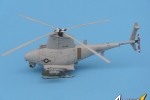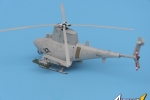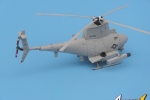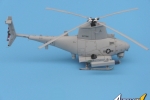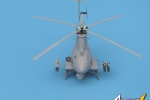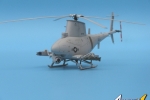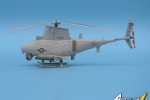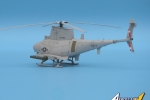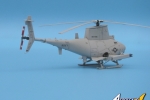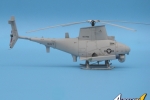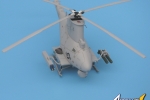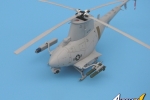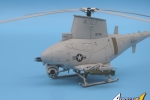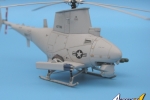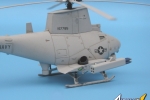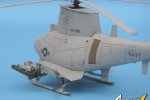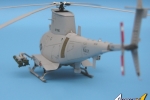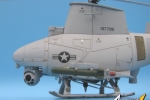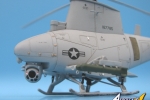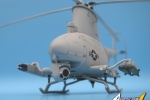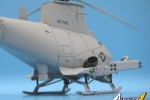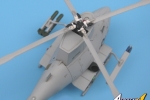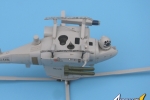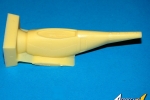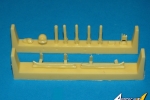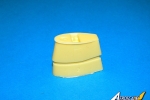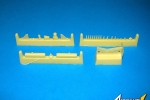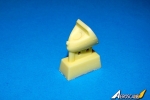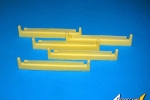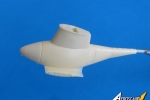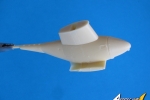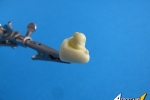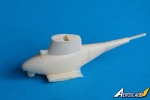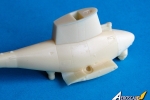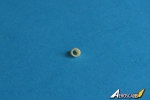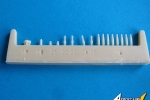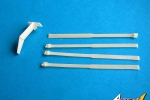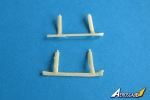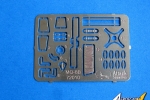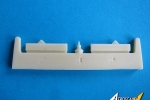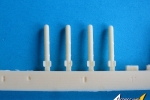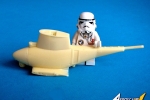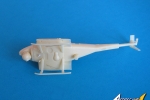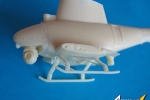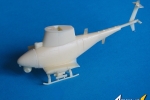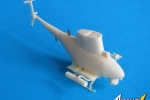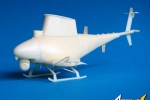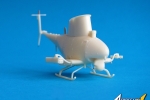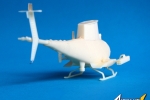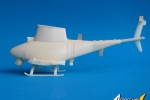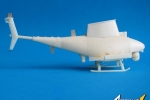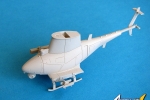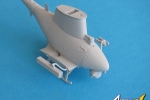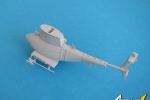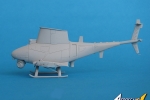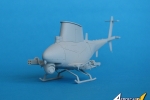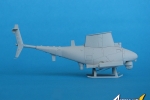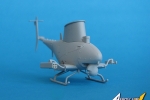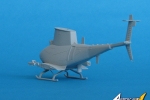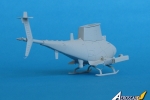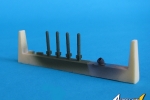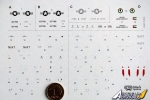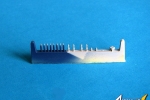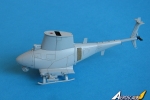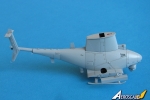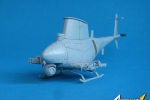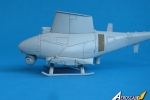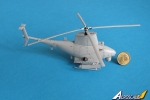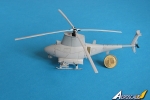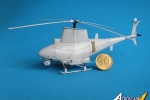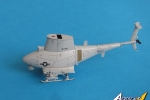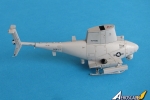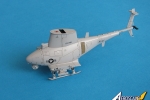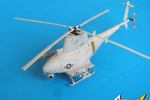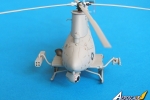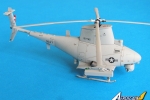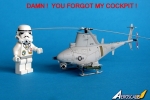1⁄72Northrop Grumman MQ-8B Fire Scout
...
Post a Comment
Northrop Grumman MQ-8B Fire Scout
Producer: Attack Squadron
Scale: 1/72
Author: Piotr Dmitruk
It is equipped with BRITE Star II electro-optical/infrared ball turret, as an armament it is intended to carry Hellfire missiles, laser- guided gliding Viper Strike bombs, and upgraded APKWS Hydra 70 infrared- guided missiles.
There will be a variety of interchangeable reconnaissance equipment such as TSAR radar, capable of detecting moving targets, or improvised explosive devices, and minefields, and multispectral sensors, electronic intelligence sensors, and tactical data link.
Parts are perfectly casted, I saw only a few micro- bubbles visible on the macro- pictures. Interestingly, there are recesses in the connections between the main parts and casting blocks. You just need to cut along them, and without grinding they ideally suit with others. In the pictures they are only inserted without glueing, and they all stick to each other. "Wings" tips and a few small items broke off during transportation, but rather due to lack of the box. In any case, it was easy to fix. Some parts need a little cleaning after cutting off. A nice gesture is providing additional rotor blade, and the blades are thin as needed. Exhaust pipe was too shallow for me, so I drilled it from the inside.
I did the same with its “saddle” in the hull.
There are two armament versions provided in the kit: APKWS Hydra 70 guided missiles and Viper Strike guided bombs.
Kit includes also a photoetched brass sheet. Manufacturer forgot about the rod placed below the tail boom, which serves for anchoring the rotor blades, and the light on the fin. I made it by myself, but as far as I know, it’s allready corrected in the kit.
Decals are from Techmod, legible even under a magnifying glass, ultra-thin, but durable. Reacts well with Agama fluids, and there was no need to use Hypersol. Unfortunately, the set lacks circular markings on the skid legs, and the warning labels on the ball turret. Microstencils were difficult to set on, due to the thinness and tending to curl. It took me a whole three hours.
Painting options.The manufacturer offers 4 options of painting. The most interesting is the one with the United Arab Emirates markings. However, this is really a prototype, remaining at the disposal of the aircraft manufacturer. It differs in details from the series version. In general, it is difficult to find two examples of this helicopter in the same hardware configuration. I chose the painting, which is the closest to the configuration proposed in my kit. Although I'm not 100% sure whether the markings should be black or dark gray. Again, manufacturer now offers additional details, essential to build the most colorful model.
Model was painted with Gunze Mr. Surfacer- its color almost perfectly matches to the original. Details were painted with Tamiya and Alclad paints, Tamiya Smoke wash and Microscale Flat varnish.
Highly recommendable!
Best regards
Piotr Dmitruk
Note from editor: right hand gallery presents finished model while the photos on the bottom shows the box content and particular stages of Piotr's work with this kit.
Producer: Attack Squadron
Scale: 1/72
Author: Piotr Dmitruk
Background
Northrop Grumman MQ-8 Fire Scout is an unmanned autonomous helicopter, developed for the U.S. Navy and Army, and which is a development of 2 passenger Schweizer 333 helicopter. The first prototype, powered by Rolls-Royce 250-C20 turbine engine, first took in the air in January 2000. In 2006, began manufacturing and testing an improved version- the MQ-8B. In 2010 Army abandoned the project funding, so far only the Navy tested this helicopter. It made his combat debut in 2010, intercepting smugglers boat, then went to Afghanistan and Libya.It is equipped with BRITE Star II electro-optical/infrared ball turret, as an armament it is intended to carry Hellfire missiles, laser- guided gliding Viper Strike bombs, and upgraded APKWS Hydra 70 infrared- guided missiles.
There will be a variety of interchangeable reconnaissance equipment such as TSAR radar, capable of detecting moving targets, or improvised explosive devices, and minefields, and multispectral sensors, electronic intelligence sensors, and tactical data link.
the kit
This is new resin 1:72 scale model kit from Attack Squadron, designed in 3D- technique, and 3D printed. And it is simply outstanding. You can’t see the polymer layers on the parts, they are visible only on the casting blocks. Interestingly, there are also part numbers imprinted on, which is useful, because there is a lot of similar items.Parts are perfectly casted, I saw only a few micro- bubbles visible on the macro- pictures. Interestingly, there are recesses in the connections between the main parts and casting blocks. You just need to cut along them, and without grinding they ideally suit with others. In the pictures they are only inserted without glueing, and they all stick to each other. "Wings" tips and a few small items broke off during transportation, but rather due to lack of the box. In any case, it was easy to fix. Some parts need a little cleaning after cutting off. A nice gesture is providing additional rotor blade, and the blades are thin as needed. Exhaust pipe was too shallow for me, so I drilled it from the inside.
I did the same with its “saddle” in the hull.
There are two armament versions provided in the kit: APKWS Hydra 70 guided missiles and Viper Strike guided bombs.
Kit includes also a photoetched brass sheet. Manufacturer forgot about the rod placed below the tail boom, which serves for anchoring the rotor blades, and the light on the fin. I made it by myself, but as far as I know, it’s allready corrected in the kit.
Decals are from Techmod, legible even under a magnifying glass, ultra-thin, but durable. Reacts well with Agama fluids, and there was no need to use Hypersol. Unfortunately, the set lacks circular markings on the skid legs, and the warning labels on the ball turret. Microstencils were difficult to set on, due to the thinness and tending to curl. It took me a whole three hours.
Painting options.The manufacturer offers 4 options of painting. The most interesting is the one with the United Arab Emirates markings. However, this is really a prototype, remaining at the disposal of the aircraft manufacturer. It differs in details from the series version. In general, it is difficult to find two examples of this helicopter in the same hardware configuration. I chose the painting, which is the closest to the configuration proposed in my kit. Although I'm not 100% sure whether the markings should be black or dark gray. Again, manufacturer now offers additional details, essential to build the most colorful model.
Model was painted with Gunze Mr. Surfacer- its color almost perfectly matches to the original. Details were painted with Tamiya and Alclad paints, Tamiya Smoke wash and Microscale Flat varnish.
Highly recommendable!
Best regards
Piotr Dmitruk
Note from editor: right hand gallery presents finished model while the photos on the bottom shows the box content and particular stages of Piotr's work with this kit.
Copyright ©2021 by Piotr Dmitruk. Images also by copyright holder unless otherwise noted. The views and opinions expressed herein are solely the views and opinions of the authors and/or contributors to this Web site and do not necessarily represent the views and/or opinions of AeroScale, KitMaker Network, or Silver Star Enterrpises. Images also by copyright holder unless otherwise noted. Opinions expressed are those of the author(s) and not necessarily those of AeroScale. All rights reserved. Originally published on: 2012-12-08 13:27:40. Unique Reads: 8677




